At this time the GCR/K-12 Team is not onsite and does not have the resources to properly decontaminate materials between check outs. This means the program has been discontinued at this time. However, we do continue to cultivate online resources for students on our website: https://k12education.
————–
BLISS Kits are age-appropriate, kid-tested, educationally sound science activities. Lab employees who have attended workshops on how to lead the activities may check out and use the kits in local schools or other appropriate youth events. Bring a little BLISS to your world!
Please note that these kits are undergoing modifications. Inquire at BLISS@lbl.gov to see if the kits you are interested in are available.
Optics and Microscopy (5th to 6th grade)
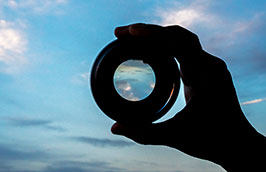
Microscopic Explorations features learning-station activities designed to ignite student curiosity in widely diverse scientific fields. Students use lenses in different ways to create magnifiers, simple cameras, telescopes, and slide projectors. They learn that lenses have certain measurable properties, which in turn determine the lens best suited for each specific purpose.
Scientific Discipline: Physics
Involving Dissolving (2nd to 4th grade)
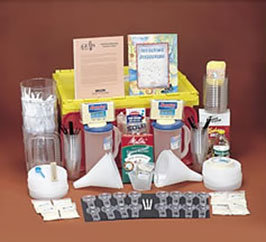
Using familiar substances, students create homemade Jell-O colorful disks and crystals that emerge on black paper to make a “starry night.” Does the substance disappear? If not, where does it go? Could it ever come back? As young students ponder these ideas and gain experience mixing and observing different solutions, they learn basic concepts in chemistry.
Scientific Disciplines: Chemistry, Energy Science
Electric Circuits (3rd to 5th grade)
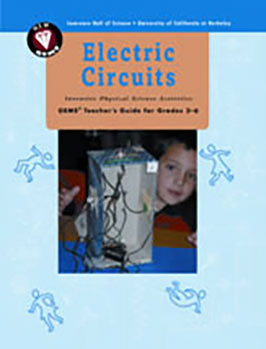
This kit provides a safe, active, and engaging introduction to electricity and electric circuits. The activities spark creativity as students invent their own electrical gadgets using inexpensive and readily available materials. The unit opens as students investigate an array of clever electrical devices, first exploring their functions, then learning how their circuits work.
Scientific Disciplines: Energy Science, Engineering
Invisible Universe (4th to 5th grade)
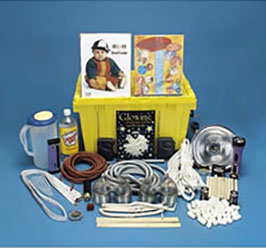
This kit allows students to gain a deeper grasp of the electromagnetic spectrum, enabling students to understand and detect wavelengths other than visible light. Activities feature energy stations, including infrared, ultraviolet, and cosmic rays. They learn how these other wavelengths can be used to see things that we cannot see with our eyes and take part in a challenge to determine how ‘invisible light’ could be used to solve a societal issue.
Scientific Discipline: Physics
DNA Extraction (7th to 8th grade)
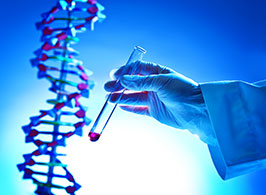
Scientists extract DNA from organisms to help them investigate everything that happens inside that organism’s cells. DNA is essentially a blueprint for all cellular activity. Students will get to formulate their own DNA extraction kit, similar to the one that scientists in research labs use, and they will extract DNA from strawberries. This kit allows students an opportunity to practice laboratory skills and see the fruits of their labor.
Scientific Discipline: Life Science
Chemical Reactions (4th to 6th grade)

Chemical Reactions explores chemical change, demonstrates endothermic and exothermic reactions, and develops skills in observation, experimentation, and inference. Students are then given an engineering and chemistry challenge: to create a device that can keep turtle eggs between 28 and 32 °C during transportation to a research lab.
Scientific Disciplines: Chemistry, Engineering
Of Cabbages and Chemistry (4th to 8th grade)
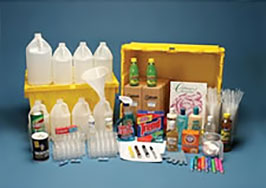
Students use the special indicator properties of red cabbage juice to investigate acids and bases, and use the juice as a resource to investigate other properties that separate the two. This is an interactive way of introducing important chemistry and biology concepts.
Scientific Discipline: Chemistry
Nanoscience (4th to 5th grade)
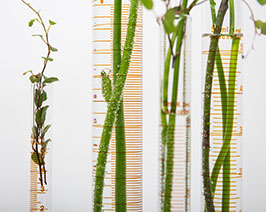
Students are introduced to the idea of nanoscience and the importance of nanotechnology for society through inventions and research conducted at Berkeley Lab. Through hands-on activities, students investigate hydrophobic properties of plants and materials. Then students engage in identifying an application for a nanotechnology developed by the Molecular Foundry.
Scientific Disciplines: Materials Science, Nanoscience
Eggs Eggs Everywhere (K to 1st grade)
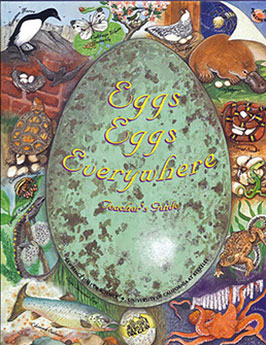
This unit introduces children to the wonders of eggs and develops developmentally-appropriate concepts in biology and life science. Activities combine literature, role-playing, drama, and art with observation of eggs, as children learn about the diversity of animals that come from eggs. They use small plastic animals for sorting, classifying, and graphing activities. Students also explore the movement of plastic eggs and other objects on flat and inclined surfaces. These activities are noteworthy for interweaving literature, mathematics, and the physical sciences with life science.
Scientific Discipline: Life Science
Penguins and Their Young (K to 1st grade)
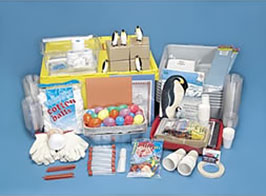
Children learn about the emperor penguin, its body structure, its cold home of ice and water, how it keeps warm, what it eats, and how parents care for their young. A life-size poster, included with the guide, invites students to compare their heights and body structures to those of this four-foot tall bird. They experience a penguin’s icy home by playing with cork penguins in a tub of “icebergs” and water.
Scientific Discipline: Life Science
For Science Fairs or Community Events
Bubbles Festival (K to 5th grade)
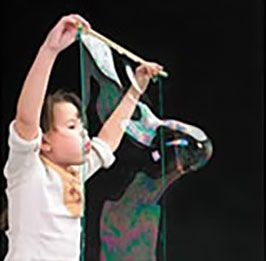
Participants investigate the iridescence, surface tension, buoyancy, and shape of bubbles. The kit includes 12 tabletop activities that can be mixed and matched to present exploratory lessons in materials science and surface chemistry.
Energy Efficiency in Light Bulbs (3rd to 8th grade)

Participants take a temperature reading using raytek thermometers of three light bulbs: incandescent, LED, and fluorescent. These temperatures can then be compared to the relative energy efficiency of the bulbs to investigate if temperature reflects heat energy produced. Optional interactive components to this activity may include charting the temperature of the light bulbs (younger groups) or calculating energy efficiency (older groups). In addition, participants can observe the light spectrum of the bulbs using a diffraction grating to see the ‘fingerprints’ of different lights.
BEETLES Science and Teaching for Field Instructors
 BEETLES student activities are designed to improve science teaching and learning in an outdoor setting.
BEETLES student activities are designed to improve science teaching and learning in an outdoor setting.
Walk & Talk
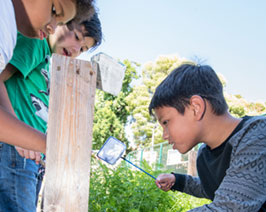 While walking from one spot to the next, students discuss prompts and questions in rotating pairs. It helps establish a learning community and a “culture of talk” for your group, in which ideas and observations are discussed and valued by all members.
While walking from one spot to the next, students discuss prompts and questions in rotating pairs. It helps establish a learning community and a “culture of talk” for your group, in which ideas and observations are discussed and valued by all members.
Students will: increase curiosity for and directly engage with aspects of the natural world; make observations, ask questions, and relate findings to past experiences; learn that descriptive observations are distinct from statements of opinion or identification.
I Notice, I Wonder, It Reminds Me of…
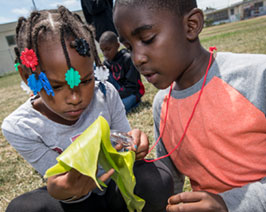 During the activity, students pick up a natural object, such as a leaf, and make “I notice…” statements out loud with a partner, then share some of their observations with the group. They do the same with “I wonder…” questions, and with “It reminds me of…” connections.
During the activity, students pick up a natural object, such as a leaf, and make “I notice…” statements out loud with a partner, then share some of their observations with the group. They do the same with “I wonder…” questions, and with “It reminds me of…” connections.
Students will: increase curiosity for and directly engage with aspects of the natural world; make observations, ask questions, and relate findings to past experiences; learn that descriptive observations are distinct from statements of opinion or identification.
What Scientist Do?
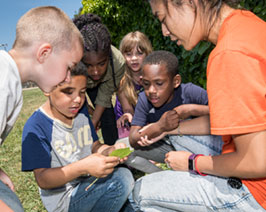 In the Science = Adventure introduction, the instructor builds up anticipation and excitement about doing field science. In the Pre: What Scientists Do, the instructor introduces some core field science practices by leading students to explore a mysterious object. Later during the Post: Debriefing Science Practices, after other field science experiences (not included in this activity), students reflect back on the science practices they engaged in and experienced.
In the Science = Adventure introduction, the instructor builds up anticipation and excitement about doing field science. In the Pre: What Scientists Do, the instructor introduces some core field science practices by leading students to explore a mysterious object. Later during the Post: Debriefing Science Practices, after other field science experiences (not included in this activity), students reflect back on the science practices they engaged in and experienced.
Students will: learn about a variety of core practices of scientists; identify as scientists; reflect on science practices they have engaged in; recognize that science can be an adventure!
Mind Pie
 In this Assessment Routine, students use a Mind Pie chart to express how comfortable and confident they feel about certain topics and activities they will encounter during the field experience.
In this Assessment Routine, students use a Mind Pie chart to express how comfortable and confident they feel about certain topics and activities they will encounter during the field experience.
Students will: evaluate their own prior knowledge; observe the group’s knowledge base for each topic; look for any patterns in the group’s responses; build an understanding of the science theme of the day.
Decomposition Mission
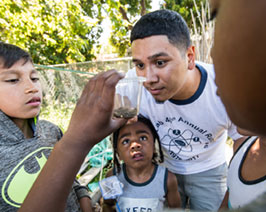 Students investigate the process of decomposition and lay the foundation for deeper understanding of concepts related to matter and energy transfer in ecosystems.
Students investigate the process of decomposition and lay the foundation for deeper understanding of concepts related to matter and energy transfer in ecosystems.
Students will: explore, observe, and compare samples of decomposing materials and use reasoning to determine the level of decomposition among them; search for and classify decomposes (or evidence of them) as fungi, bacteria or invertebrates; investigate and discuss decomposition as the process of breaking down dead organisms and their waste materials into smaller and simpler forms of matter; create a model diagram for the process of decomposition; discuss the role decomposers play in making matter available to living plants.
Structures and Behaviors
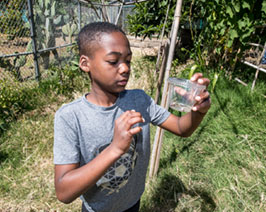 Observing an organism for an extended period of time can be a rewarding learning experience that helps students develop a meaningful relationship with the natural world.
Observing an organism for an extended period of time can be a rewarding learning experience that helps students develop a meaningful relationship with the natural world.
Students will: identify structures and behaviors of an organism; create explanations of possible benefits of structures and behaviors of organisms; understand that adaptations are inheritable structures or behaviors that help a population of organisms survive in their habitat; make connections between the structure and function of different features of an organism.

